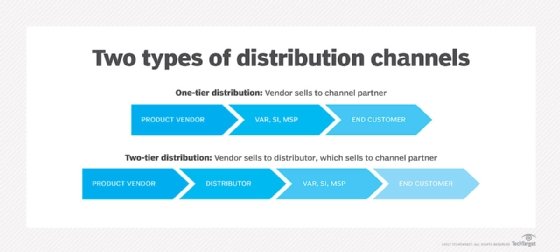What Is a Direct Channel of Distribution
A distribution channel is the network of individuals and organizations involved in getting a product or service from the producer to the customer. Distribution channels are also known as marketing channels or marketing distribution channels.
Direct vs. indirect distribution channel
The two primary channels are direct and indirect, but there are different subchannels within those categories. With the direct channel, the vendor of a product or service sells directly to the customer. The vendor may maintain its own sales force to close deals with clients or sell its products or services through an e-commerce website. The direct channel approach requires vendors to take on the expense of hiring and training a sales team or building and hosting an e-commerce operation.
Dell grew its consumer personal computer (PC) business in the 1990's and 2000's using the direct sales model. On its website, Dell enabled customers to customize the configuration of their PC, order it and have it shipped to their homes. Dell launched its website in July 1996 and a year later, was receiving $3 million in sales per day.
In a 1998 article in Fast Company, Scott Eckert, director of Dell Online said, "In a survey of our online customers, 40% said that they chose Dell because of its Internet offerings. And 80% of them are new to the company. The Web's real power is that it helps customers help themselves."
The indirect channel, in contrast, offloads sales activities to individuals and organizations known as intermediaries. Examples of intermediaries include value-added resellers (VARs), consultants, systems integrators (SIs), managed service providers (MSPs), original equipment manufacturers (OEMs), independent software vendors (ISVs), wholesalers and distributors.
HP uses an indirect channel to distribute its products and services. The HP channel consists of resellers, authorized support partners and authorized parts partners. Retailers sell HP products online and in physical stores. An HP partner and store locator page notes, "Whether you're looking for HP products, services, or support, there are thousands of HP retailers and resellers ready to help."
Examples of distribution channels
Each type of intermediary represents a channel, with its own distinct characteristics. VARs, for example, are often local companies that sell horizontal (accounting) or vertical (manufacturing) IT solutions to the businesses in their geographic region. SIs may be large, national companies that work on highly complex, multivendor IT projects. Consultants may not resell solutions at all but rather influence sales through product recommendations to customers. A vendor develops a channel strategy, also known as a distribution channel strategy, to determine what types of intermediaries to target and how to optimize partner relationships to increase sales and improve distribution.
The indirect distribution channel has three categories:
- Intensive distribution: a large number of intermediaries
- Selective distribution: a smaller number of intermediaries, using criteria set by the vendor (e.g., geographic region, service and support capabilities)
- Exclusive distribution: only a few intermediaries, who agree to exclusively sell the vendor's products
Types of distribution channels
Indirect channels may be configured in different ways. Single-tier distribution is a channel design in which vendors develop direct relationships with channel partners that sell to the end customer. In the two-tier distribution model, the vendor sells to distributors, which provide products to channel partners, such as VARs and SIs, which, in turn, package solutions for the end customer. Two-tier distribution helps smaller channel partners that would have difficulty establishing direct sales relationships with large IT vendors.

Partner enablement
As vendors grow the size and scope of their distribution network, dedicated resources are often needed to ensure the success of the partner program. Reporting to the heads of sales or marketing, Partner Enablement Managers are focused on the success of the partner program.
Partner enablement includes the creation of co-branded sales and marketing material and the training of partners' sales and marketing staff. The partner enablement manager facilitates communication and collaboration between the partners and assorted stakeholders and executives on the vendor side. The partner enablement manager also creates a partner certification program, which defines tiers of certification, along with the requirements to meet each tier.
Understanding multichannel distribution
A product vendor may decide to employ more than one channel when selling its product, an approach referred to as multichannel distribution. For example, a vendor may decide to deploy a direct sales force to sell to large enterprise accounts, establish a VAR channel to sell to small and medium-sized businesses and use physical retail stores or e-commerce sites to sell to consumers.
This distribution channel model has the potential to uncover more sales opportunities but can also result in channel conflict. A VAR, for instance, might believe a vendor's direct channel sales force or e-commerce site is disintermediating indirect channels. Channel conflict is a serious issue; if unaddressed by the vendor, it can strain vendor-partner relationships and compromise the effectiveness of entire channels.
The importance of distribution channels
The various channels of distribution play a critical role in a vendor's go-to-market strategy. If successfully executed, any distribution channel model -- whether focused entirely on one mode, such as direct sales, or embracing multiple outlets, such as multichannel distribution -- can open or expand markets, generate sales and grow a vendor's top line.
Beyond boosting revenue, distribution channels can also broaden the portfolio of products and services available to end customers. VAR, SI and MSP channel partners, for instance, often provide consulting, technology implementation services and post-sales support. They may also incorporate a vendor's product into an integrated IT solution.
The end customer is focused on whether a product or solution meets their needs. They're often unaware or unconcerned about the intricacies of distribution channels.
This was last updated in May 2019
Continue Reading About distribution channel
- Marketing distribution channels
- How the vendor/distributor relationship benefits channel partners
- Distributors offer partners a growing service menu
- Distributors specialize in cloud computing
- Distributors invest in partner enablement
Dig Deeper on Channel partner program news
-

channel partner rules of engagement (ROE)

By: Spencer Smith
-

5 steps to build partnerships with IT distribution companies

By: Scott Ford
-
![]()
HPE points distribution to everything as a service
By: Simon Quicke
-

Commvault reveals EMEA distribution rationalisation

By: Christine Horton
What Is a Direct Channel of Distribution
Source: https://searchitchannel.techtarget.com/definition/distribution-channel
